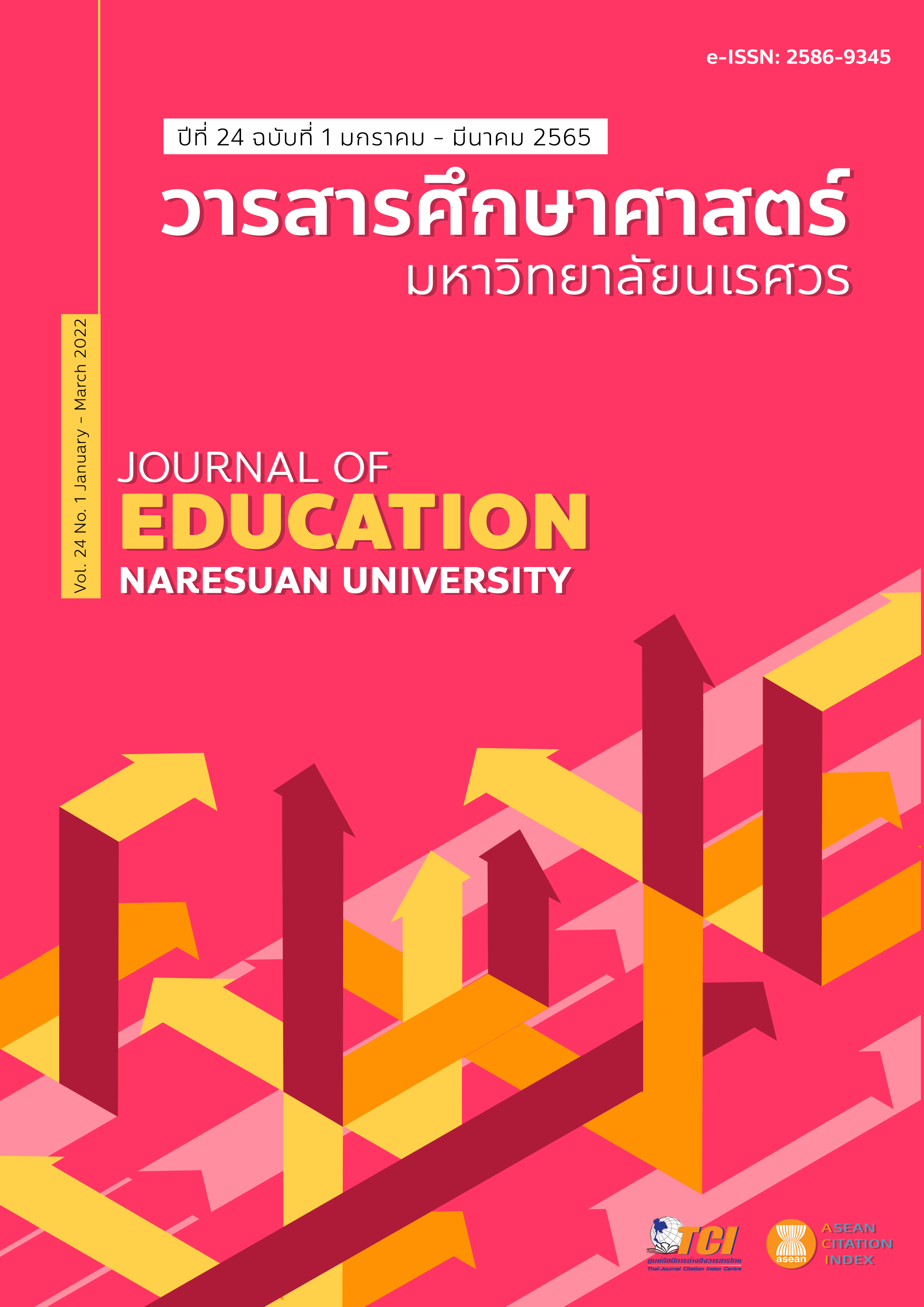ASSESSMENT OF JUNIOR HIGH SCHOOL STUDENTS’ CRITICAL THINKING SKILLS การประเมินทักษะการคิดอย่างมีวิจารณญาณของนักเรียนมัธยมศึกษาตอนต้น
Main Article Content
Abstract
Critical thinking skills is one of the goals of science learning in domains of cognitive, affective, and psychomotor. There were few research mentioned affective aspects as a component of critical thinking. This study, therefore, aimed to explore 35 grade 7 students’ critical thinking skills. Paper-and-pencil test of critical thinking skills was used as a collection tool. Content analysis and constant comparison were employed for analyzing data. The collected frequencies of students’ critical thinking indicators were converted to percentage. Findings showed that the most of students had moderate level of critical thinking skills, except the components of problem solving which low level and moderate level were equally. Considering the behavioral indicators of each component, the component of systems thinking had the highest difference of percentage between high and moderate level. Moreover, the components of give reason effectively, make judgments and decisions, and consider affective dimensions had the highest percentage in moderate level. The implications of this study, teachers will be able to use these findings as the supported problems to adjust and improve their activities which can support and enhance students’ critical thinking skills in cognitive, affective, and psychomotor domains.
Article Details

This work is licensed under a Creative Commons Attribution-NonCommercial-NoDerivatives 4.0 International License.
The owner of the article does not copy or violate any of its copyright. If any copyright infringement occurs or prosecution, in any case, the Editorial Board is not involved in all the rights to the owner of the article to be performed.
References
Arsal, Z. (2017). The impact of inquiry-based learning on the critical thinking dispositions of pre-service science teachers. International Journal of Science Education, 39(10), 1326-1338.
Bailin, S., Case, R., Coombs, J. R., & Daniels, L. B. (1999). Conceptualizing critical thinking. Journal of Curriculum Studies, 31(3), 285-302.
Bensley, D. A., & Murtagh, M. P. (2012). Guidelines for a scientific approach to critical thinking assessment. Teaching of Psychology, 39(1), 5-16.
Byrne, M. S., & Johnstone, A. H. (1987). Critical thinking and science education. Studies in Higher Education, 12(3), 325-339.
Chantavanich, S. (2018). Qualitative research (24th ed.). Bangkok: Chulalongkorn University Press. [in Thai]
Chatthong, N., & Thongkamsuk, P. (2018). A study of the critical thinking abilities by upper-secondary students of the Demonstration School of Bansomdejchaopraya Rahabhat. Journal of Education and Human Development Sciences, 2(2), 146-152. [in Thai]
Ennis, R. H. (1993). Critical thinking assessment. Theory into Practice, 32(3), 179-186.
Hohmann, J. W., & Grillo, M. C. (2014). Using critical thinking rubrics to increase academic performance. Journal of College Reading and Learning, 45(1), 35-51.
Kim, K., Sharma, P., Land, S. M., & Furlong, K. P. (2013). Effects of active learning on enhancing student critical thinking in an undergraduate general science course. Innovative Higher Education, 38(3), 223-235.
Ku, K. Y. (2009). Assessing students’ critical thinking performance: Urging for measurements using multi-response format. Thinking Skills and Creativity, 4(1), 70-76.
Lai, E. R. (2011). Critical thinking: A literature review. Pearson's Research Reports, 1-50.
Macpherson, K., & Owen, C. (2010). Assessment of critical thinking ability in medical students. Assessment & Evaluation in Higher Education, 35(1), 41-54.
Miri, B., David, B. C., & Uri, Z. (2007). Purposely teaching for the promotion of high-order thinking skills: A case of critical thinking. Research in Science Education, 37(4), 353-369.
Moore, T. (2013). Critical thinking: Seven definitions in search of a concept. Studies in Higher Education, 38(4), 506-522.
Muangpanao, N., & Keeratichamroen, W. (2018). Learning achievement and critical thinking ability for grade 11 students using inquiry method management (7E) with concept map. Academic Services Journal, Prince of Songkla University, 29(3), 40-49. [in Thai]
Oliveras, B., Márquez, C., & Sanmartí, N. (2013). The use of newspaper articles as a tool to develop critical thinking in science classes. International Journal of Science Education, 35(6), 885-905.
Partnership for 21st century skills. (2007). P21 framework definitions. Retrieved from http://www.p21.org/about-us/p21-framework
Pattaranont, N., & Sengsri S. (2010). Development of learning WebQuest to enhance critical thinking for mathayomsuksa 5 students. Journal of Education Naresuan University, 12(2), 95-110. [in Thai]
Singkha, L., & Suwannoi, P. (2012). The development of grade 11 students’ critical thinking and scientific concept in chemistry reaction rate by using predict-observe-explain learning activities. Journal of Education, Khon Kaen Univerisity, 35(2), 93-102. [in Thai]
Sukhanthawanit, P., & Sittisomboon, M. (2017). The effect of authentic learning using historical method to promote the critical thinking ability of grade 8 students. Journal of Education Naresuan University, 19(4), 188-199. [in Thai]
Wang, H. H., Chen, H. T., Lin, H. S., Huang, Y. N., & Hong, Z. R. (2017). Longitudinal study of a cooperation-driven, socio-scientific issue intervention on promoting students’ critical thinking and self-regulation in learning science. International Journal of Science Education, 39(15), 2002-2026.
Wass, R., Harland, T., & Mercer, A. (2011). Scaffolding critical thinking in the zone of proximal development. Higher Education Research & Development, 30(3), 317-328.


